How do I improve my ad performance with Facebook interest targeting?
Given that Facebook reaches over 2 billion people around the world, the potential to reach the consumers you need to reach is very large. Through Facebook interest targeting you can tailor your ads to users based on demographics, behavior, hobbies, or anything else that gives you a complete picture of your ideal customer.
How is Interest Targeting Used in Facebook Ads in 2020?
Historically, interest targeting was among the first ways you could target an ad on Facebook. While it remained a common targeting method, it eventually was surpassed by the use of data and Lookalike audiences.
By late 2018, machine learning and leaning into the Facebook Ads algorithm meant using “broad audiences” (using little to no targeting) within Campaign Budget Optimization. This was often in conjunction with a second ad set using a targeted lookalike.
By early 2020, our preferred campaign structure would allow the algorithm to choose between a very broad audience and an “expanded” lookalike audience. In other words, the pendulum has swung back towards Interest Targeting.
To do this requires some basic steps:
Figure out which interests are relevant to your business. As you’ll see below, Facebook gives you a long list of options to use for tailoring your ad. Figure out which interests matter for what you are selling. There are dozens of categories and sub-categories to help you get as specific as you want or need. The trick is first understanding which ones matter.
Monitor KPI’s. Often you need to optimize for ROAS, cost per purchase, or cost per lead. Compare the performance of your key metric within interest audiences and against other targeting methods.
Use Audience Insights. This tool removes most of the guesswork out of first time targeting, leading to reduced CPA, better value cost-per-click, and higher ROI. Audience Insights makes it easy to access data for three specific groups of people: The general Facebook audience, people who are connected to your Facebook page or event, and people in Custom Audiences that you have created that consists of current customers.
Using Audience Insights, marketers can aggregate data such as:
- Demographics. Age and gender, lifestyle, education, relationship status, job role, and household size
- Facebook page likes. The top pages that people like in different categories.
- Location and language. Where do people live, and what languages do they speak.
- Facebook usage. How frequently are people in your target audience logging onto Facebook and what device(s) they are using when they log on.
- Purchase activity. What they bought in the past and how they are buying.
What options are available in Facebook interest targeting?
Facebook offers many options in interest targeting, especially if you’re targeting large audiences. Here is an abbreviated list of what is available to you:
- Location
- Age
- Gender
- Language
- Relationship
- Education (level, the field of study, schools attended, years attended)
- Financial (income, net worth)
- Work (employers, job title, industries)
- Home (type, ownership status, household composition)
- Ethnic affinity
- Generation
- Parents
- Life events
- Politics
- Interests (business and industry, entertainment, fitness and wellness, family, food and drink, sports, fashion, hobbies, technology)
- Behaviors
What are the most effective approaches to Facebook interest targeting?
The most effective way to make Facebook interest targeting work for you is to find 2-3 large theme interest audiences and test them against one another to find the best performer.
After and during these tests, using “expanded interest audiences” is a best practice as we want to give the algorithm as much freedom as possible to use its signals to serve the ad tot he next person it “thinks” will convert based on our objectives.

Another effective approach is to check ad relevance diagnostics for new opportunities to improve targeting. To date, Facebook has three diagnostics for its ads:
- Quality ranking. If your ranking here is low, change the target audience to one that’s more likely to respond to the ad’s message.
- Engagement rate ranking. Here, refine your targeting to reach people most likely to engage using Facebook’s Audience Insights tool.
- Conversion rate ranking. Target people who will most likely to find your message relevant.
What are the alternatives to interest targeting?
Facebook’s Custom Audiences is very helpful in how it enables you to build your own audiences based on your website visitors and their engagement on your site or app. This way you can only serve your ads to those who’ve given real indicators in being potential customers.
This could mean only targeting people who have been on your website three times in the last seven days, someone who has visited more than five pages in the past 30 days, or you can now even target people based on how much time they spend on your site. That’s a lot more telling than what might be listed in their interests on a profile that is older than 10 years!
Lookalike audiences is a method to reach new people who are likely to be interested in your business because they’re similar to your best existing customers. Lookalike Audiences are created by choosing a Custom Audience based on data pulled from fans of your Facebook page. From there you identify common qualities of those users; Facebook then sends your ad to an audience of people with similar traits — The “Lookalike” Audience, essentially.
It is essential to continually test and to “follow the signals” in your conversion funnel to improve the quality of your traffic and boost your conversions. Interest targeting was foundational to early Facebook ad targeting, and after being surpassed by Lookalike Audiences, is now again driving top results with the use of large audiences and expanded interest targeting.




